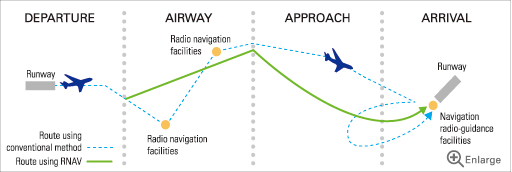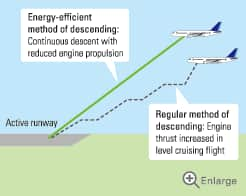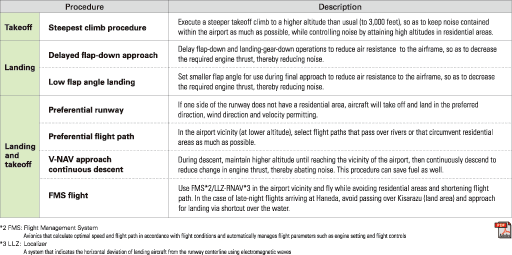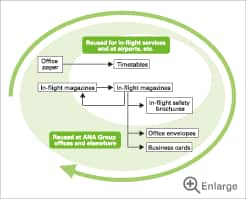Our Various Initiatives
Reducing Environmental Impact in Our Operations
Introduction of Next-Generation Aircraft
Environmental Impact in Our Operations
Reducing fuel consumed by aircraft is directly connected to reducing environmental impact. We have long been actively engaged in a variety of fuel reduction measures in flight and ground operations. ANA has improved flight efficiency since the previous fiscal year through the formation of Team ASPIRE*1, a body supervised by the Civil Aviation Bureau of the Ministry of Land, Infrastructure and Transport. The following are some of the initiatives the ANA Group is undertaking.
*1 |
ASPIRE: The Asia and Pacific Initiative to Reduce Emissions, the name given to activities aimed at reducing fuel consumption and gas emissions through joint efforts by air traffic control agencies and airlines to conduct efficient operations. |
When Preparing for Departure

Shared use of GPU power
Proactive Use of
Ground Power Units
Parked aircraft normally consume electric power by running APUs*2 for such uses as air conditioning and lighting inside the aircraft. However, since 1990 the ANA Group has actively used ground power units (GPUs), which are much more energy efficient, instead of APUs. As a result, in the fiscal year ended March 2010, we reduced CO2 emissions by 97,000 tons and fuel consumption by 39,600 kiloliters compared to not using GPUs. These savings are equivalent to the emissions of a Boeing 777-200 making approximately 2,600 round trips between Tokyo and Osaka.
*2 |
APU: Auxiliary Power Unit, a small on-board gas turbine that provides electricity for the aircraft and compressed air for starting the engine and air conditioning. APUs are less energy efficient than GPUs as they burn jet fuel. |
When Cruising
Operation of RNAV (Area Navigation)
RNAV navigation is a procedure that navigates aircraft and assures the scheduled flight path by radio-navigation facilities as well as by satellite and on-board equipment. Not only does RNAV achieve faster and shorter fights while reducing fuel consumption and CO2 emissions, it also reduces noise around airports.
RNAV Navigation vs. Conventional Routing
When Descending
Promoting Energy-Efficient
Descent Method
When an aircraft descends continuously from the start to the end of its descent without leveling off, it saves fuel, cuts CO2emissions and reduces noise. Official Continuous Descent Operation (CDO*4) at Kansai International Airport began in June 2010. The ANA Group will cooperate with associated organizations to implement the system at other airports.
| *4 | CDO: Continuous Descent Operation, a collective term for operations including CDA (continuous descent approach), TA (tailored arrival), OPM (optimum profile descent), etc. |
When Arriving at Airports
Reducing the Power of Thrust Reversers for Landing
Normally, in order to reduce an aircrafts landing length, thrust reversers are employed, engine thrust is increased (which emits CO2) and the exhaust is sent forward. By landing with the engines in idle to the extent possible when it is safe to do so, based on an assessment of the landing length and other factors, CO2 emissions are reduced and noise pollution is mitigated, which makes this method of landing more environmentally friendly. In the fiscal year ended March 2010, this reduced CO2 emissions by 13,700 tons and fuel consumption by 5,580 kiloliters.
Initiatives in Areas Other Than Flight Operations
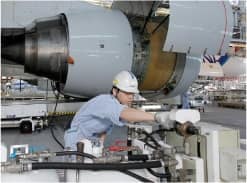
Engine washing
Maintaining Peak Engine
Performance by Washing Engine
Compressor Sections
During engine use, minute lumps that reduce fuel economy collect on the compressor section. Since 2003, the ANA Group has been using original engine washing machines to wash dust off engine compressor sections to maintain peak engine performance and improve fuel usage. As a result of maintaining peak performance after washing, we reduced CO2 emissions by 43,000 tons and fuel consumption by 17,500 kiloliters in the year ended March 2010. These savings are equivalent to the emissions of a Boeing 777-200 making approximately 1,150 round trips between Tokyo and Osaka.
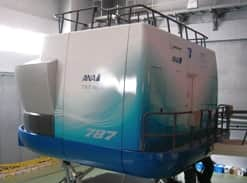
Simulator
Saving Fuel Through Use of
Simulators
The ANA Group mainly uses flight simulators to train and evaluate flight crews, thereby reducing fuel consumption (CO2 emissions) and noise, and helping us make the most of limited air space.
In FY 2009, if total simulator hours were actual flight time, they would have emitted 650,000 tons of CO2 and required 266,000 kiloliters of fuel in FY 2009, saving about 18,000 round trips between Tokyo and Osaka (Itami) on a Boeing 777-200.
Introduction of Next-Generation Aircraft
Boeing 787
As launch customer of the Boeing 787, ANA participated in the planning and development stages of the aircraft. Ahead of any airline in the world, we ordered 55 Boeing 787s as a successor to the Boeing 767, mainstay of our fleet, and have put these revolutionary airplanes into service, one after another, since November 2011.
Boeing 787
Next-Generation Mitsubishi Regional Jet (MRJ)
ANA has decided to introduce the next-generation Mitsubishi Regional Jet (MRJ), to be developed by Mitsubishi Aircraft Corporation. ANA has placed a firm order for 15 MRJ aircraft and 10 options as the launch customer.
The MRJ will be the first regional jet to use composite material for the wings and a vertical stabilizer. The new engine driven by the latest technology will significantly reduce the environmental impact of the aircraft. State-of-the-art aerodynamics should bring about an approximate 40% savings in fuel compared with current aircraft in the same class.
Next-Generation Mitsubishi Regional Jet (MRJ)
Noise

The ANA Groups entire fleet conforms to Chapter 4, the strictest of the ICAO*1 noise standard s. ANA has been examining various flight procedures to decrease the noise reaching the ground.
| *1 | International Cargo Aviation Organization |
Strict Compliance with Environmental Law
The ANA Group is involved in a diverse range of businesses from aircraft and car maintenance plants to cabin cleaning services. Each Group business facility is subject to an average of seven environmental laws and regulations, including the Waste Disposal and Public Cleansing Act. In all these activities, the ANA Group strictly complies with relevant environmental laws and regulations.

Promotion Resource Efficiency
The ANA Group is actively involved in conservation of resources, including its 3R (reduce, reuse and recycle) activities. For paper resources, ANA has reduced use of business forms and recycles paper used in its offices. In addition, in-flight magazines including Wingspan and ANA Sky Shop, entertainment programs and menu cards are collected and recycled to make items such as timetables, envelopes or business cards that are used in the Groups offices throughout the country. ANA is also actively engaged in reusing and recycling used uniforms.
